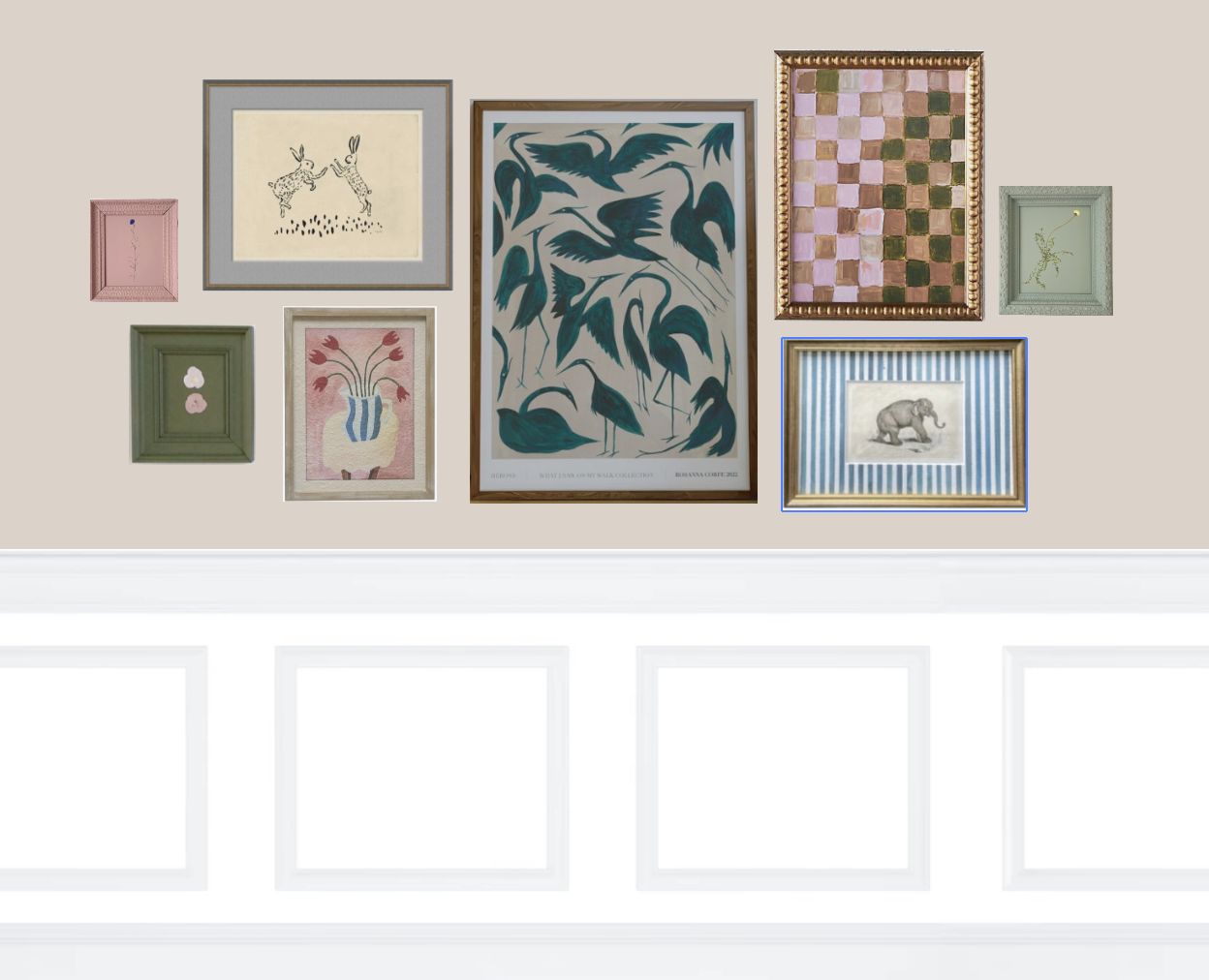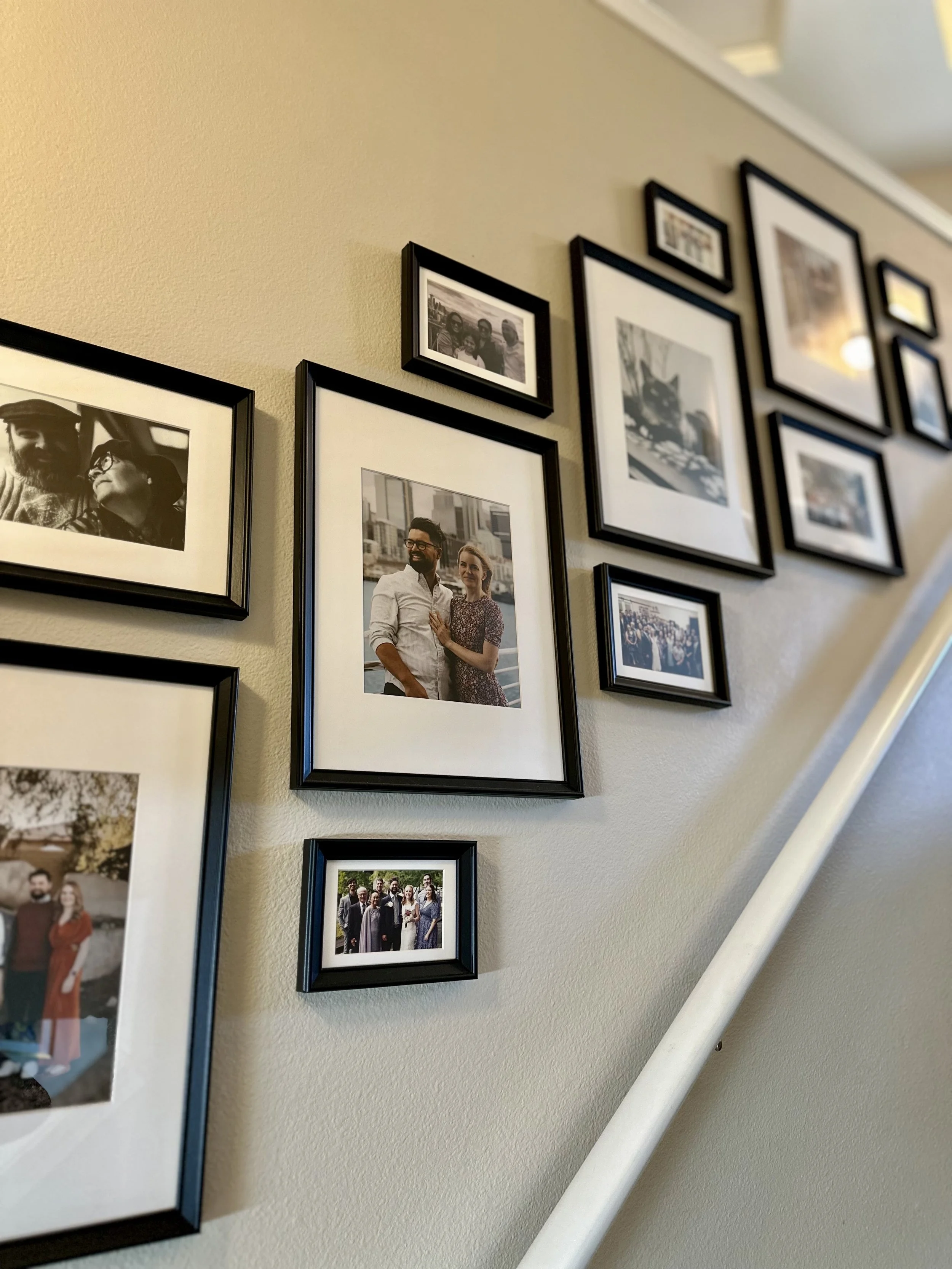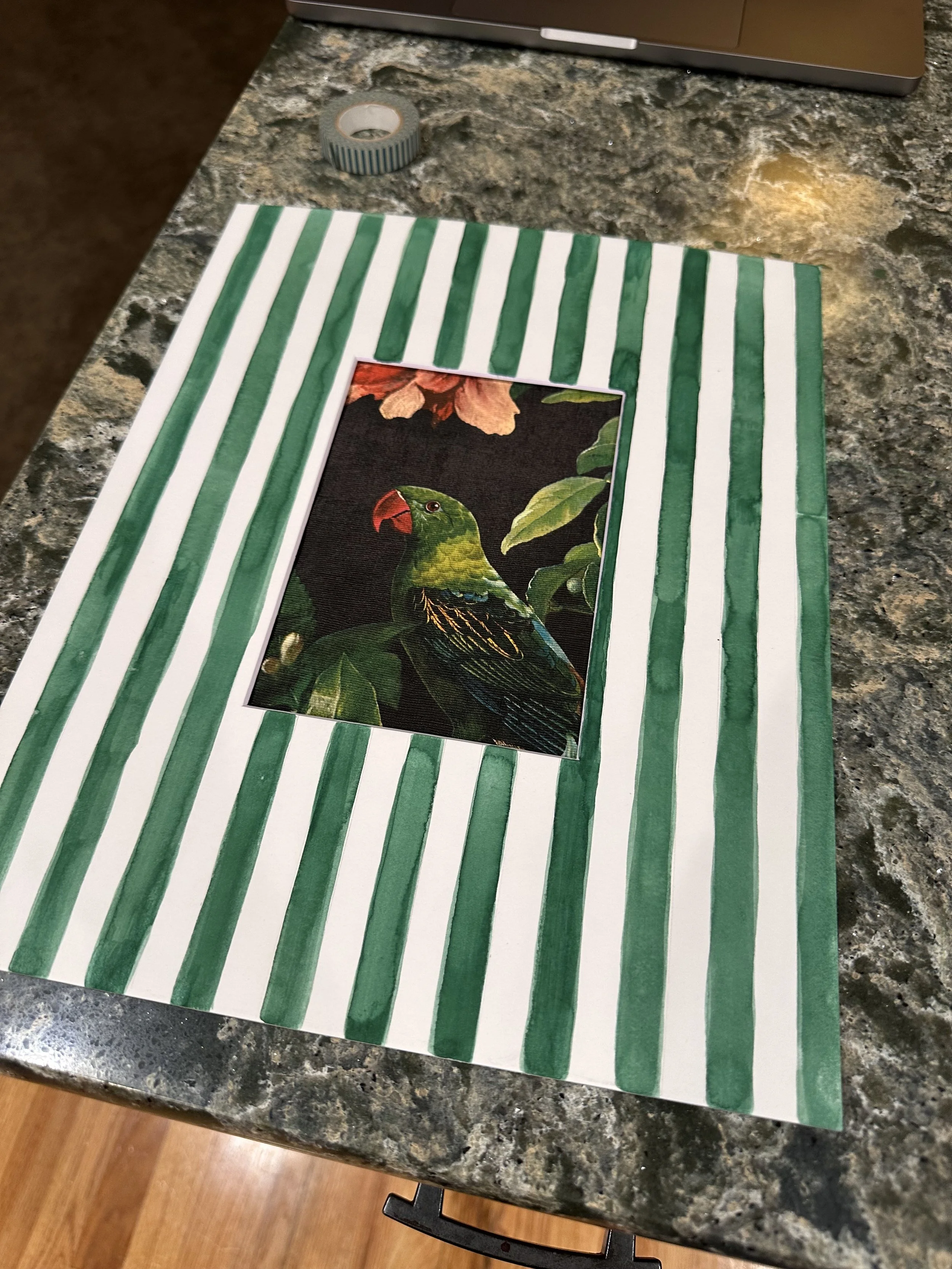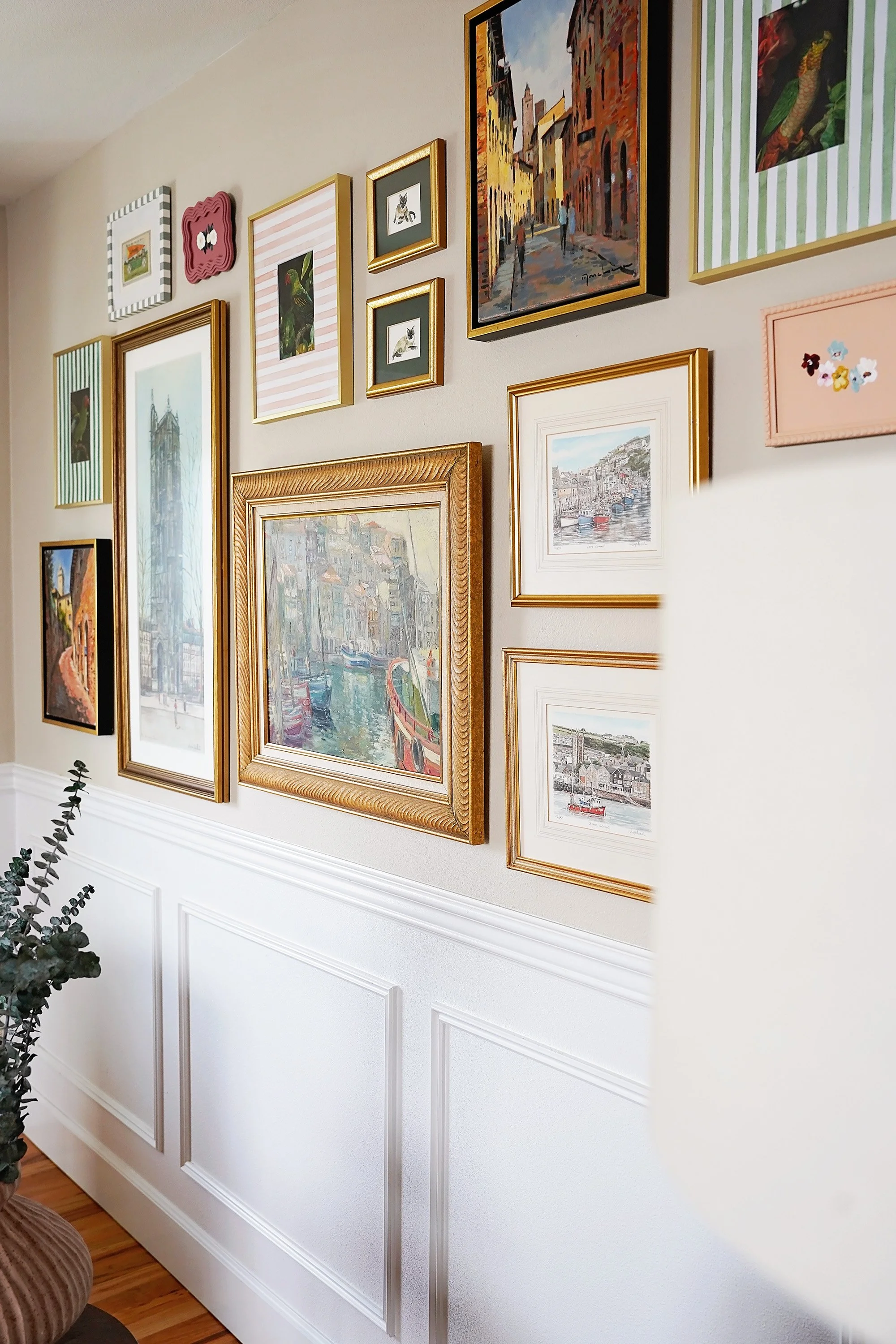Creating Your Perfect Gallery Art Wall: A Step-by-Step Guide With Unique Tips
Creating a balanced, well-curated gallery wall is both an art and a science. Here are some expert tips and recommendations to help you curate a truly stunning gallery art wall in your home that reflects your unique style, personality, and the story you want to tell through your chosen pieces.
1. Choose Your Frames Wisely
Consistent Frames: Opt for all the same frame style and color to achieve a clean, unified look that brings harmony to your space. This approach works especially well for arrangements that feature a grid or straight-line layout and is especially easy to accomplish. I love this set of frames for a sophisticated look. Or nine (or more) of these frames to create the look below.
Matching gold frames in a grid is the easiest way to create a gallery wall that showcases your favorite photos or prints.
Mixed Frames: To achieve an eclectic and interesting design, try mixing different sizes and types of frames for visual interest. To keep the look cohesive, include a unifying element like a consistent color scheme or choice of material. For instance, you could use all black frames that vary in width or all wood frames with mixed ornamentation, or a balanced mix of two to three selected styles. Start with this group of frames for an quick way to create a more collected look. To achieve the most authentic, curated look, visit thrift stores or flea markets for frames with character.
A mix of gold and warm wood frames work together in this cozy gallery wall moment. The addition of antique plates brings it home. (Photo credit: Unsplash)
2. Curating the Art
Authentic Pieces: Showcase your personal art collection, unique thrifted finds or family heirlooms. I generally like to choose a piece that I know I want to put in the gallery, then make decisions around that. Sticking to a medium, a subject matter, and/or a color palette, helps keep things looking and feeling intentional.
Every piece on this wall tells part of my story—from the art we acquired on our honeymoon to consigned treasures and things I’ve made myself.
Mass-Produced Art: Incorporate prints from an online vendor or local shop that resonate with your style. If you’re just starting out with your art collecting, this is a wonderful way to show your personality through your selections. A couple really great online vendors that have thousands of prints to choose from and allow you to customize your print sizes are desenio.com and pstrstudio.com. Filter by theme, subject or color to narrow down your search. Or head to Etsy for endless downloadable prints that you can print at home or order prints of. I like to drag images into an art program like Photoshop, Canva or Milanote to play around with the prints I’m considering side by side before purchasing them.
A mock-up to demonstrate how I would arrange potential art prints into a cohesive and balanced gallery wall to ensure they are harmonious together.
Family or Vacation Photos: Consider turning your photos into black and white or sepia tones for a cohesive look. I like to throw on a consistent filter over my photos before sending them to a printer so the images just feel right together.
DIY Art: If you’re not a fan of mass-produced art, try creating your own artwork to add a personal touch and complement existing pieces. Say you have a handful of thrifted cat art and want a few more, consider creating a portrait of your own cat to add to the gallery.
3. Creative Use of Mats
Color and Size: Experiment with mats in different colors and sizes to enhance and frame your artwork interestingly.
Layering: Use layered mats to add depth and interest to pieces within your gallery wall.
Painted: Consider painting your mats with stripes or another design. Watercolor or acrylics work well.
Fun art and matte idea!
I painted an oversized mat with watercolors that coordinated with my home’s color palette. The art is repurposed wallpaper from my powder room renovation.
4. Plan Your Layout
Arrangement: Arranging your art on the floor or a large flat surface is a great way to explore different layouts before committing to a wall. Use painter’s tape to define the dimensions of the wall on the surface. This will help you visualize how the pieces will interact with each other and ensure that the arrangement feels balanced. Experiment with spacing and configurations. I start with the largest piece(s) and build around those. They will anchor the whole arrangement. Then I fill in with the medium pieces going back and forth between left and right, asking myself if the pieces feel balanced. I follow with the smallest pieces, doing the same thing. It takes time and deliberation. I will the the arrangement sit there for hours, then return to it with fresh eyes to determine whether it sits well or not. It’s a process.
Arranging art on the floor lets you try different layouts before hanging them on the wall. Mark the wall's size on the floor with painter’s tape to help you see how everything fits.
Eye-Level Rule: When hanging your artwork, it is recommended to position the center of each piece between 57”-60” from the floor. This height range is generally regarded as the average eye level for most individuals. If your gallery wall is situated above a couch, then the bottom of the arrangement should be about 6”-8” from the top of the couch.
Spacing: To achieve a balanced look, be sure to maintain consistent spacing between frames, typically around 2-3 inches apart. If you’re working with very large pieces, then the space between pieces should increase (up to 6 inches or so). Think of it as a proportions game. With that said, I think very large pieces shouldn’t be subject to gallery walls and should stand alone. The exception would be if one were hanging a gallery wall on an enormous wall, then larger pieces with larger spacing is justified.
5. Final Touches
Lighting: Consider spotlighting or track lighting to highlight specific pieces and create a gallery-like ambiance.
Our powder room with a wire-free gallery light from Amazon.
Adjust and Experiment: Don't be afraid to rearrange or swap out pieces until you find the perfect balance and flow.
Creating a gallery art wall is not just about decorating your walls but also about telling your story through carefully curated pieces. Whether you prefer a minimalist grid or a vibrant mix of styles, these tips will help you create a visually captivating and meaningful art display in your home. Happy decorating!











